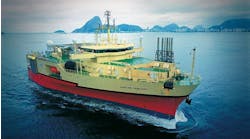Plectrum to acquire 2D seismic
Plectrum has awarded a contract to acquire 3,000 km (1,864 mi) of 2D seismic data over the Nabeul block, offshore Tunisia, to Compagnie Generale de Geophysique (CGG).
Original Nabeul block seismic results.
MVCGG Princess will acquire the data in 2Q 2007 over the entire block, which contains a number of previously identified prospects and leads.
Reprocessed Nabeul block seismic results.
Plectrum recently completed reprocessing 1,000 km (621 mi) of older regional seismic data over the Nabeul block. These reprocessed seismic lines show an improvement in data quality, confirming earlier assessments. The results also gave additional leads on trend with the neighboring Oudna field, 12 km (7 1/2 mi) to the west.
The seismic data were reprocessed by Seismic Image Processing Ltd. using the pre-stack time migration process.
Nabeul covers 3,352 sq km (1,294 sq mi) equivalent to 13 North Sea blocks) and is in water depths of 250-300 m (820-984 ft). Prospective structures have been identified in the Birsa sand fairway play.
“The award of this contract marks a turning point for Plectrum as we move forward into offshore operations,” says executive chairman Mike Whyatt. “We are reviewing our seismic processing options for the 2007 survey and will update the market accordingly once we have finalized our plans.”
Geophysical, well data for Sicily Channel
Grove Energy Ltd. is integrating its 2D seismic data shot in December 2004 and review of well log reports from the Dougga-1 well in the Sicily Channel drilled in 1981, plus 2D seismic data from the former holder of the Kerkouane exploration permit. Work completed to date has helped define the Sambuca prospect and indicates a potentially hydrocarbon bearing structure near the Dougga-1 well.
Grove has mapped this structure and conducted petrophysical re-evaluations of the well logs. On the basis of this information the company has decided to engage independent experts to prepare a reserve estimate.
3D fault analysis tool
Gaz de France and ffA have agreed to develop a 3D fault analysis toolset aimed at giving a more accurate reservoir model and reserve estimates.
The 3D seismic attribute analysis tools will enable a greater understanding of the impact of faults on the distribution and extraction of hydrocarbons, supporting well placement and maximization of recovery.
“Gaz de France believes the techniques being developed in collaboration with ffA will enable us to have a 3D understanding of the degree to which faults, as geobodies, may act as flow barriers,” says Jean-François Dutzer, Geophysics R&D manager.
“This can have a major impact on our exploration risking and development strategies and therefore on the economics associated with a reservoir.”
Wavefield Inseis building 3D vessel
Wavefield Inseis AS plans to launch a purpose-built 3D seismic vessel. The new flagship,Geowave Endeavour, is scheduled to begin operations in April 2008.
Geowave Endeavour to be flagship of Wavefield Inseis.
With 16 streamer capacity and eight gun strings, the vessel has been designed to meet the growing demand for high-density 4D seismic data and the need for wide-azimuth and multi-azimuth data acquisition. The vessel also incorporates design elements that will allow it to accommodate advances in acquisition technology and to provide techniques such as under/over streamers and source configurations.
The Volstad Maritime AS-owned vessel will be built by the Fosen Yard in Norway.
Wavefield also has chartered a vessel from Geo ASA. The large-capacity 3D vessel, to be namedGeowave Master, was chartered for seven years with options up to 17 years.
Undergoing conversion in Norway for delivery in May 2007, the vessel is 117 m (384 ft) long by 22.5 m (74 ft) wide. It will be rigged for 12-streamer acquisition and is designed for 3D, 4D, multi-azimuth, and wide-azimuth use.
SCAN begins seismic survey off Venezuela
SCAN Geophysical ASA has begun 3D seismic acquisition program for Chevron offshore Venezuela. The survey encompasses two non-adjacent areas and is expected to take several months to complete.
The M/VSCAN Resolution, arrived in Venezuela to acquire the data following a survey in the Mediterranean. The vessel features solid-streamer and source technology, incorporating an environmentally friendly design for quiet operation in moderate seas.
“We have been looking forward to conducting our first seismic survey in the Americas,” says Stephane Touche, senior vice president and COO of SCAN. “This not only establishes our presence in an important new market, but also is consistent with our plan to expand seismic value worldwide.”
SCAN operates one 2D and one 3D streamer vessel and will launch three new 3D vessels and one 2002-built 2D vessel in 2007.
Gene Kliewer, Houston






